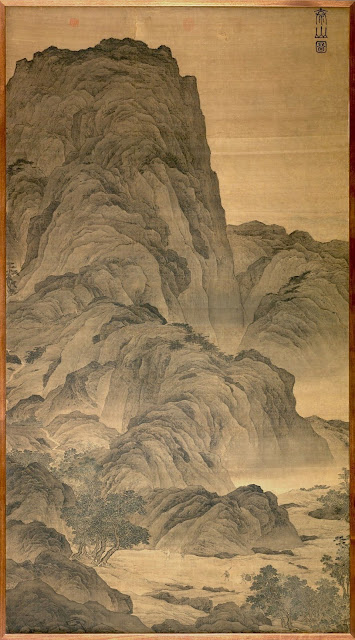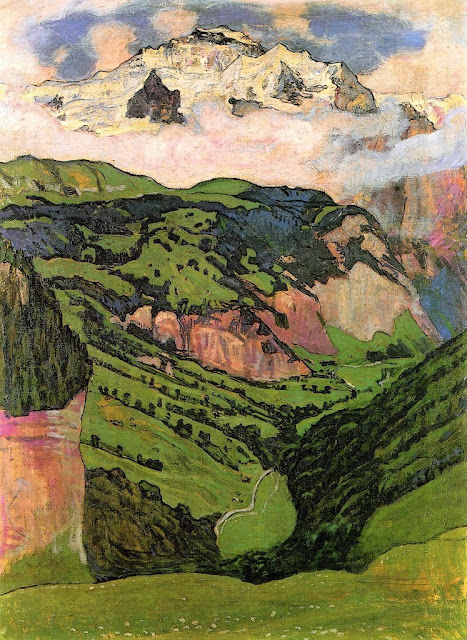CASPAR DAVID FRIEDRICH (1774-1840)
Schneekoppe or Sněћka or Śnieżka (1,603m - 2,259ft)
Poland - Czech Republic border
In Ruine im Riesengebirge, oil on canvas, Pommersches Landesmuseum
The mountain
Schneekoppe (1,603m - 2,259ft) in German or Sněћka in Czech or Śnieżka in Polish, is a mountain on the border between the Czech Republic and Poland, the most prominent point of the Silesian Ridge in the Krkonoše mountains. Its summit is the highest point in the Czech Republic, in the Krkonoše and in the entire Sudetes range system.
The first historical account of an ascent to the peak is in 1456, by an unknown Venetian merchant searching for precious stones. The first settlements on the mountain soon appeared, being primarily mining communities, tapping into its deposits of copper, iron and arsenic. The mining shafts, totalling 1.5 kilometres (0.93 mi) in length, remain to this day.
The first recorded German name was Riseberg ("giant mountain"), mentioned by Georg Agricola in 1546. Fifteen years later the name Riesenberg appears on Martin Helwig's map of Silesia. The German name later changed to Riesenkoppe ("giant top") and finally to Schneekoppe ("snow top", "snowy head").
In Czech, the mountain was initially called Pahrbek Sněžný. Later Sněžka, with the eventual name Sněžovka, meaning "snowy" or "snow-covered", which was adopted in 1823.
An older Polish name for the mountain was Góra Olbrzymia, meaning "giant mountain".
The first building on the mountaintop was the Chapel of Saint Lawrence (Laurentiuskapelle), built ca. 1665–1681 by the Silesian Schaffgotsch family to mark their dominion, serving also as an inn for a brief period of time. The territory including the mines were the property of the Schaffgotsch family until 1945. The so-called Prussian hut was built on the Silesian (now Polish) side in 1850, followed by the Bohemian hut on the Bohemian (now Czech) side in 1868, both built with the purpose of providing lodging. The Prussian hut was rebuilt twice after fires (1857 and 1862), and the (after 1945) "Polish hut" was finally demolished in 1967. The Bohemian hut fell into disrepair after 1990 and was demolished in 2004.
The painter
Caspar David Friedrich was a 19th-century German Romantic landscape painter, considered as the most important German artist of his generation. He is best known for his mid-period allegorical landscapes which typically feature contemplative figures silhouetted against night skies, morning mists, barren trees or Gothic ruins. His primary interest as an artist was the contemplation of nature, and his often symbolic and anti-classical work seeks to convey a subjective, emotional response to the natural world. Friedrich's paintings characteristically set a human presence in diminished perspective amid expansive landscapes, reducing the figures to a scale that, according to the art historian Christopher John Murray, directs "the viewer's gaze towards their metaphysical dimension".
Friedrich was born in Pomerania, where he began to study art. He studied in Copenhagen until 1798, before settling in Dresden. A disillusionment with materialistic society was giving rise everywhere in Europe. This shift in ideals was often expressed through a reevaluation of the natural world, as artists such as Friedrich, J. M. W. Turner (1775–1851) and John Constable (1776–1837) sought to depict nature as a "divine creation, to be set against the artifice of human civilization".
Friedrich's work brought him renown early in his career, and contemporaries such as the French sculptor David d'Angers (1788–1856) spoke of him as a man who had discovered "the tragedy of landscape". Nevertheless, his work fell from favour during his later years, and he died in obscurity, and in the words of the art historian Philip B. Miller, "half mad". As Germany moved towards modernisation in the late 19th century, a new sense of urgency characterized its art, and Friedrich's contemplative depictions of stillness came to be seen as the products of a bygone age. The early 20th century brought a renewed appreciation of his work, beginning in 1906 with an exhibition of thirty-two of his paintings and sculptures in Berlin. By the 1920s his paintings had been discovered by the Expressionists, and in the 1930s and early 1940s Surrealists and Existentialists frequently drew ideas from his work. The rise of Nazism in the early 1930s again saw a resurgence in Friedrich's popularity, but this was followed by a sharp decline as his paintings were, by association with the Nazi movement, interpreted as having a nationalistic aspect. It was not until the late 1970s that Friedrich regained his reputation as an icon of the German Romantic movement and a painter of international importance.
Friedrich was a prolific artist who produced more than 500 attributed works. In line with the Romantic ideals of his time, he intended his paintings to function as pure aesthetic statements, so he was cautious that the titles given to his work were not overly descriptive or evocative. It is likely that some of today's more literal titles, such as The Stages of Life, were not given by the artist himself, but were instead adopted during one of the revivals of interest in Friedrich. Complications arise when dating Friedrich's work, in part because he often did not directly name or date his canvases. He kept a carefully detailed notebook on his output, however, which has been used by scholars to tie paintings to their completion dates.
2018 - Wandering Vertexes...
Un blog de Francis Rousseau



















